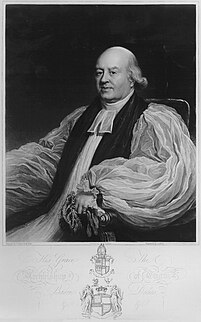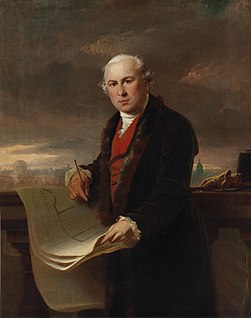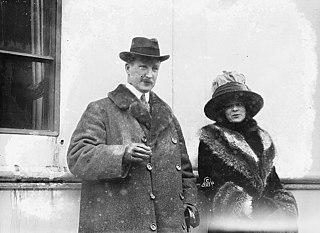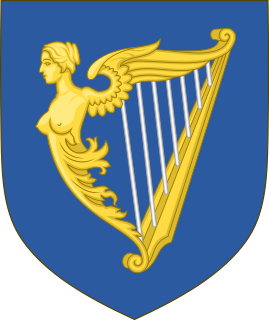
The Custom House is a neoclassical 18th century building in Dublin, Ireland which houses the Department of Housing, Planning and Local Government. It is located on the north bank of the River Liffey, on Custom House Quay between Butt Bridge and Talbot Memorial Bridge.

Marquess of Waterford is a title in the Peerage of Ireland and the premier marquessate in that peerage. It was created in 1789 for George Beresford, 2nd Earl of Tyrone. It is presently held by Henry Beresford, 9th Marquess of Waterford.

Earl Annesley, of Castlewellan in the County of Down, is a title in the Peerage of Ireland. It was created on 17 August 1789 for Francis Annesley, 2nd Viscount Glerawly, with special remainder to his younger brother the Honourable Richard Annesley. He had previously represented Downpatrick in the Irish House of Commons. The titles of Baron Annesley, of Castlewellan in the County of Down, and Viscount Glerawly, in the County of Fermanagh, were created in the Peerage of Ireland on 20 September 1758 and 14 November 1766 respectively for his father William Annesley, who sat as Member of the Irish Parliament for Midleton. Annesley was the sixth son of the Honourable Francis Annesley, fourth son of Francis Annesley, 1st Viscount Valentia.

Baron Decies, of Decies in the County of Waterford, is a title in the Peerage of Ireland. It was created in 1812 for the Right Reverend William Beresford, Archbishop of Tuam from 1794 to 1819. He was the third son of the Marcus Beresford, 1st Earl of Tyrone, and the younger brother of the George Beresford, 1st Marquess of Waterford. His son, the second Baron, married Charlotta Philadelphia Horsley, only daughter and heiress of Robert Horsley, and assumed the additional surname of Horsley in 1810. However, none of the subsequent barons have held this surname. His grandson, the fifth Baron, was a Major in the Army and also sat in the House of Lords as an Irish Representative Peer from 1912 to 1944. As of 2013 the title is held by his grandson, the seventh Baron, who succeeded his father in 1992. As a descendant of the first Earl of Tyrone he is also in remainder to that peerage and its subsidiary titles, which are now held by his kinsman the Marquess of Waterford.

William Brabazon Ponsonby, 1st Baron Ponsonby , PC (Ire) was a leading Irish Whig politician, being a member of the Irish House of Commons, and, after 1800, of the United Kingdom parliament. Ponsonby was the son of the Hon. John Ponsonby, the Speaker of the Irish House of Commons and Lady Elizabeth Cavendish, daughter of the 3rd Duke of Devonshire. He was invested as a Privy Counsellor of Ireland in 1784. He served as Joint Postmaster-General of Ireland (1784–1789).

General William Carr Beresford, 1st Viscount Beresford, 1st Marquis of Campo Maior, was an Anglo-Irish soldier and politician. A general in the British Army and a Marshal in the Portuguese Army, he fought alongside The Duke of Wellington in the Peninsular War and held the office of Master-General of the Ordnance in 1828 in Wellington's first ministry.

James Gandon (1743–1823) is today recognised as one of the leading architects to have worked in Ireland in the late 18th century and early 19th century. His better known works include The Custom House, the Four Courts, King's Inns in Dublin and Emo Court in County Laois.
Baron Beresford is a title that was created three times for the Beresford family, one in the Peerage of Ireland and later also two in the Peerage of the United Kingdom. In all instances it was created for men who were eminent politicians or soldiers. The first creation still exists as a subsidiary title, but the latter two became extinct at the death of their original holder.

St Patrick's Cathedral, Armagh is the seat of the Archbishop of Armagh in the Church of Ireland. It is located in Armagh, Northern Ireland. It is also the cathedral of the Diocese of Armagh.

John Beresford PC, PC (Ire) was an Irish statesman.

John Graham Hope Horsley de la Poer Beresford, 5th Baron Decies PC, styled The Honourable John Beresford until 1910, was an Anglo-Irish army officer, civil servant and polo player in the 1900 Summer Olympics.
John Sobieski Stuart and Charles Edward Stuart were names used by John Carter Allen and Charles Manning Allen, two 19th-century brothers who are best known for their role in Scottish cultural history. As authors of a dubious book on Scottish tartans and clan dress, the Vestiarium Scoticum, they are the source of some current tartan traditions.

Lord John George de la Poer Beresford was an Anglican archbishop and Primate.
John Beresford, MBE is an English former football player who played as a defender, who is currently a pundit for ESPN.

William Beresford, 1st Baron Decies was an Anglo-Irish clergyman.

Marcus Gervais Beresford was the Church of Ireland Bishop of Kilmore, Elphin and Ardagh from 1854 to 1862 and Archbishop of Armagh and Primate of All Ireland from 1862 until his death.
Sir Tristram Beresford, 1st Baronet was an Irish soldier and politician. He was the ancestor of the Marquesses of Waterford, the Barons Decies and the Beresford baronets, of William Beresford, 1st Viscount Beresford and Charles Beresford, 1st Baron Beresford.
The Rt. Rev. George de la Poer Beresford was an Irish bishop.
John Beresford Allan was an Irish-born soldier, businessman and political figure in Manitoba. He represented St. Clements from 1883 to 1886 in the Legislative Assembly of Manitoba as a Conservative.
Sir Mark Beresford Russell Grant-Sturgis KCB was a British civil servant who served as Assistant Under-Secretary for Ireland.












